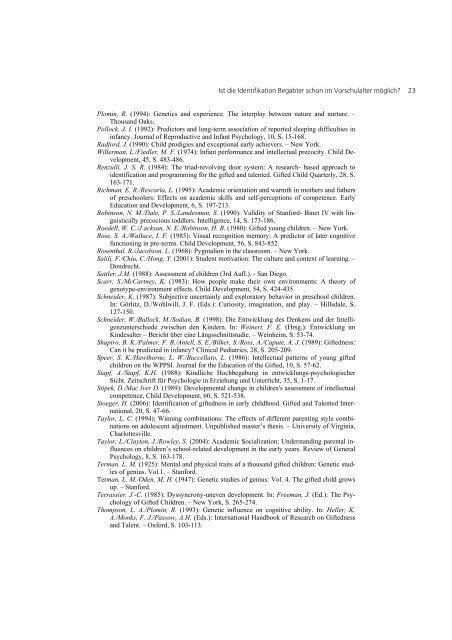Ist die Identifikation Begabter schon im Vorschulalter möglich? Ein ...
Ist die Identifikation Begabter schon im Vorschulalter möglich? Ein ...
Ist die Identifikation Begabter schon im Vorschulalter möglich? Ein ...
Sie wollen auch ein ePaper? Erhöhen Sie die Reichweite Ihrer Titel.
YUMPU macht aus Druck-PDFs automatisch weboptimierte ePaper, die Google liebt.
<strong>Ist</strong> <strong>die</strong> <strong>Identifikation</strong> <strong>Begabter</strong> <strong>schon</strong> <strong>im</strong> <strong>Vorschulalter</strong> <strong>möglich</strong>? 23<br />
Plomin, R. (1994): Genetics and experience. The interplay between nature and nurture. –<br />
Thousand Oaks.<br />
Pollock, J. I. (1992): Predictors and long-term association of reported sleeping difficulties in<br />
infancy. Journal of Reproductive and Infant Psychology, 10, S. 15-168.<br />
Radford, J. (1990): Child prodigies and exceptional early achievers. – New York.<br />
Willerman, L./Fiedler, M. F. (1974): Infant performance and intellectual precocity. Child Development,<br />
45, S. 483-486.<br />
Renzulli, J. S. R. (1984): The triad-revolving door system: A research- based approach to<br />
identification and programming for the gifted and talented. Gifted Child Quarterly, 28, S.<br />
163-171.<br />
Richman, E. R./Rescorla, L. (1995): Academic orientation and warmth in mothers and fathers<br />
of preschoolers: Effects on academic skills and self-perceptions of competence. Early<br />
Education and Development, 6, S. 197-213.<br />
Robinson, N. M./Dale, P. S./Landesman, S. (1990): Validity of Stanford- Binet IV with linguistically<br />
precocious toddlers. Intelligence, 14, S. 173-186.<br />
Roedell, W. C./J ackson, N. E./Robinson, H. B. (1980): Gifted young children. – New York.<br />
Rose, S. A./Wallace, I. F. (1985): Visual recognition memory: A predictor of later cognitive<br />
functioning in pre-terms. Child Development, 56, S. 843-852.<br />
Rosenthal, R./Jacobson, L. (1968): Pygmalion in the classroom. – New York.<br />
Salili, F./Chiu, C./Hong, Y. (2001): Student motivation: The culture and context of learning. –<br />
Dondrecht.<br />
Sattler, J.M. (1988): Assessment of children (3rd Aufl.). - San Diego.<br />
Scarr, S./McCartney, K. (1983): How people make their own environments: A theory of<br />
genotype-environment effects. Child Development, 54, S. 424-435.<br />
Schneider, K. (1987): Subjective uncertainly and exploratory behavior in preschool children.<br />
In: Görlitz, D./Wohlwill, J. F. (Eds.): Curiosity, <strong>im</strong>agination, and play. – Hillsdale, S.<br />
127-150.<br />
Schneider, W./Bullock, M./Sodian, B. (1998): Die Entwicklung des Denkens und der Intelligenzunterschiede<br />
zwischen den Kindern. In: Weinert, F. E. (Hrsg.): Entwicklung <strong>im</strong><br />
Kindesalter – Bericht über eine Längsschnittstu<strong>die</strong>. – Weinhe<strong>im</strong>, S. 53-74.<br />
Shapiro, B. K./Palmer, F. B./Antell, S. E./Bilker, S./Ross, A./Capute, A. J. (1989): Giftedness:<br />
Can it be predicted in infancy? Clinical Pediatrics, 28, S. 205-209.<br />
Speer, S. K./Hawthorne, L. W./Buccellato, L. (1986): Intellectual patterns of young gifted<br />
children on the WPPSI. Journal for the Education of the Gifted, 10, S. 57-62.<br />
Stapf, A./Stapf, K.H. (1988): Kindliche Hochbegabung in entwicklungs-psychologischer<br />
Sicht. Zeitschrift für Psychologie in Erziehung und Unterricht, 35, S. 1-17.<br />
Stipek, D./Mac Iver D. (1989): Developmental change in children's assessment of intellectual<br />
competence, Child Development, 60, S. 521-538.<br />
Stoeger, H. (2006): Identification of giftedness in early childhood. Gifted and Talented International,<br />
20, S. 47-66.<br />
Taylor, L. C. (1994): Winning combinations: The effects of different parenting style combinations<br />
on adolescent adjustment. Unpublished master’s thesis. – University of Virginia,<br />
Charlottesville.<br />
Taylor, L./Clayton, J./Rowley, S. (2004): Academic Socialization: Understanding parental influences<br />
on children’s school-related development in the early years. Review of General<br />
Psychology, 8, S. 163-178.<br />
Terman, L. M. (1925): Mental and physical traits of a thousand gifted children: Genetic stu<strong>die</strong>s<br />
of genius. Vol.1. – Stanford.<br />
Terman, L. M./Oden, M. H. (1947): Genetic stu<strong>die</strong>s of genius: Vol. 4. The gifted child grows<br />
up. – Stanford.<br />
Terrassier, J.-C. (1985): Dyssyncrony-uneven development. In: Freeman, J. (Ed.): The Psychology<br />
of Gifted Children. – New York, S. 265-274.<br />
Thompson, L. A./Plomin, R. (1993): Genetic influence on cognitive ability. In: Heller, K.<br />
A./Monks, F. J./Passow, A.H. (Eds.): International Handbook of Research on Giftedness<br />
and Talent. – Oxford, S. 103-113.


